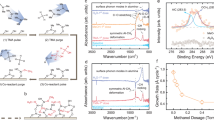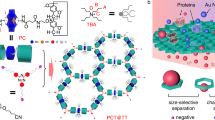Abstract
A mesoporous membrane composed of nanochannels with a uniform diameter has a potential use for precise size-exclusive separation of molecules. Here, we report a novel method to form a hybrid membrane composed of silica–surfactant nanocomposite and a porous alumina membrane, by which size-selective transport of molecules across the membrane becomes possible. The nanocomposite formed inside each columnar alumina pore was an assembly of surfactant-templated silica-nanochannels with a channel diameter of 3.4 nm; the channel direction being predominantly oriented along the wall of the columnar alumina pore. Molecules could be transported across the membrane including the silica–surfactant nanocomposite with a capability of nanometre-order size-exclusive separation. Our proposed membrane system has a potential use not only for separation science, but also catalysis and chip technologies.
This is a preview of subscription content, access via your institution
Access options
Subscribe to this journal
Receive 12 print issues and online access
$259.00 per year
only $21.58 per issue
Buy this article
- Purchase on Springer Link
- Instant access to full article PDF
Prices may be subject to local taxes which are calculated during checkout




Similar content being viewed by others
References
Rouhi, A.M. From membrane to nanotubes. Sci. Technol. 79, 29–33 (2001).
Jirage, K.B., Hulteen, J.C. & Martin, C.R. Nanotube-based molecular-filtration membranes. Science 278, 655–658 (1997).
Lee, S.B. et al. Antibody-based bio-nanotube membranes for enantiomeric drug separations. Science 296, 2198–2200 (2002).
Yang, H., Kuperman, A., Coombs, N., M.-Afara, S. & Ozin, G.A. Synthesis of oriented films of mesoporous silica on mica. Nature 379, 703–705 (1996).
Ogawa, M. Formation of novel oriented transparent films of layered silica–surfactant nanocomposites. J. Am. Chem. Soc. 116, 7941–7942 (1994).
Ogawa, M. A simple sol-gel route for the preparation of silica–surfactant mesostructured materials. Chem. Commun. 1149–1150 (1996).
Lu, Y. et al. Continuous formation of supported cubic and hexagonal mesoporous films by sol-gel dip-coating. Nature 389, 364–368 (1997).
Brinker, C.J., Lu, Y., Sellinger, A. & Fan, H. Evaporation induced self-assembly: nanostructures made easy. Adv. Mater. 11, 579–585 (1999).
Lu, Y. et al. Aerosol-assisted self-assembly of mesostructured spherical nanoparticles. Nature 398, 223–226 (1999).
Schacht, S., Huo, Q., V.-Martin, I.G., Stucky, G.D. & Schüth, F. Oil-water interface templating of mesoporous macroscale structures. Science 273, 768–711 (1996).
Diggle, J.W., Downie, T.C. & Goulding, C.W. Anodic oxide films on aluminum. Chem. Rev. 69, 365–405 (1969).
Sing, K.S., Everett, D.H., W. Haul, R.A., Moscou, L. & Pierotti, R.A. Reporting physisorption data for gas/solid systems with special reference to the determination of surface area and porosity. Pure Appl. Chem. 57, 603–619 (1985).
Kresge, C.T., Leonowicz, M.E., Roth, W.J., Vartuli, J.C. & Beck, J.S. Ordered mesoporous molecular sieves synthesized by a liquid-crystal template mechanism. Nature 359, 710–712 (1992).
Beck, J.S. et al. A new family of mesoporous molecular sieves prepared with liquid crystal template. J. Am. Chem. Soc. 114, 10834–10843 (1992).
Tanamura, Y. et al. Ship-in-a-bottle synthesis of copper phthalocyanine molecules within mesoporous channels of MCM-41 by a chemical vapor deposition method. Nano Lett. 1, 387–390 (2001).
Sarbolouki, M.N. A general diagram for estimating pore size of ultrafiltration and reverse osmosis membrane. Sep. Sci. Technol. 17, 381–386 (1982).
Acknowledgements
We thank Eiji Aoyanagi and Yuichiro Hayasaka, High-Voltage Electron Microscope Laboratory, Tohoku University, and Shun Ito, Analytical Research Core for Advanced Materials, Institute for Material Research, Tohoku University, for SEM and TEM measurements. We also thank Hiroaki Misawa, Hokkaido University, for useful discussions about alumina membranes. This work was supported in part by a Grant in Aid for Scientific Research (No. 14204074, No. 13129201, No. 15750062) from the Ministry of Education, Culture, Sports, Science and Technology, Japan, JSPS-RFTF (Research for the Future Program from the Japan Society for the Promotion of Science), and the Asahi Glass Foundation.
Author information
Authors and Affiliations
Corresponding author
Ethics declarations
Competing interests
The authors declare no competing financial interests.
Supplementary information
Supplementary Information, Fig. S1
Supplementary Information, Fig. S2 (PDF 1114 kb)
Rights and permissions
About this article
Cite this article
Yamaguchi, A., Uejo, F., Yoda, T. et al. Self-assembly of a silica–surfactant nanocomposite in a porous alumina membrane. Nature Mater 3, 337–341 (2004). https://doi.org/10.1038/nmat1107
Received:
Accepted:
Published:
Issue Date:
DOI: https://doi.org/10.1038/nmat1107
This article is cited by
-
Slow-Growing Titanium Dioxide on Ti-48Al Porous Alloy Mediated by Nb and Cr Addition: Perspective via Local Metal–Oxygen Bonding Strength
Journal of Materials Engineering and Performance (2020)
-
Mesostructure and orientation control of lyotropic liquid crystals in a polysiloxane matrix
Polymer Journal (2019)
-
Self-assembled membrane composed of amyloid-like proteins for efficient size-selective molecular separation and dialysis
Nature Communications (2018)
-
Vertically Oriented Microporous Membranes Prepared by Bidirectional Freezing
Chinese Journal of Polymer Science (2018)
-
In-situ Synthesis of SiO2 Nanoparticles on Polyester Fabric as Benign Multi-purpose Catalysts
Fibers and Polymers (2018)



